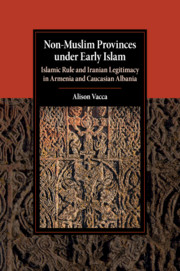 Non-Muslim Provinces under Early Islam
Non-Muslim Provinces under Early Islam Book contents
- Frontmatter
- Dedication
- Contents
- List of Illustrations
- Acknowledgments
- Situating Places, People, and Dates
- 1 Non-Persian Provinces of Iran, Non-Muslim Provinces of Islam: An Introduction to the Umayyad and ʿAbbāsid North
- 2 Whence the Umayyad North?: Byzantine, Sasanian, and Caliphal Administrative Geography of the North
- 3 Lost Greek Kings and Hoodwinked Khazars: Sasanian and Byzantine Legacy in the Construction of Caliphal Frontiers in the North
- 4 The So-Called Marzb ā ns and the Northern Freemen: Local Leadership in the North from Sasanian to Caliphal Rule
- 5 Caliphs, Commanders, and Catholicoi: Mechanisms to Control the North under Byzantine, Sasanian, and Caliphal Rule
- 6 Taxing the Dead and Sealing the Necks of the Living: Sasanian and Caliphal Treaties and Taxation in the North
- 7 Collective Historical Amnesia: The Case for a Parthian Intermezzo
- Bibliography
- Index
- Miscellaneous Endmatter
Situating Places, People, and Dates
Published online by Cambridge University Press: 08 September 2017
- Frontmatter
- Dedication
- Contents
- List of Illustrations
- Acknowledgments
- Situating Places, People, and Dates
- 1 Non-Persian Provinces of Iran, Non-Muslim Provinces of Islam: An Introduction to the Umayyad and ʿAbbāsid North
- 2 Whence the Umayyad North?: Byzantine, Sasanian, and Caliphal Administrative Geography of the North
- 3 Lost Greek Kings and Hoodwinked Khazars: Sasanian and Byzantine Legacy in the Construction of Caliphal Frontiers in the North
- 4 The So-Called Marzb ā ns and the Northern Freemen: Local Leadership in the North from Sasanian to Caliphal Rule
- 5 Caliphs, Commanders, and Catholicoi: Mechanisms to Control the North under Byzantine, Sasanian, and Caliphal Rule
- 6 Taxing the Dead and Sealing the Necks of the Living: Sasanian and Caliphal Treaties and Taxation in the North
- 7 Collective Historical Amnesia: The Case for a Parthian Intermezzo
- Bibliography
- Index
- Miscellaneous Endmatter
Summary
Balancing Armenian, Georgian, Albanian (as much as possible), Arab, and Iranian traditions demands that we establish certain patterns and norms from the start for the sake of consistency. We rely here on certain conventions intended to increase readability and accessibility. Dates appear streamlined as the Common Era rather than the hijrī of Arabic and Persian texts, the Armenian era, the anno mundi of Byzantine sources, or the Georgian kronikon system. To further assist the reader, the index serves as a short glossary including a snippet definition of foreign terms and short details about authors and political figures, including date of death when available.
Other choices might not appear self-evident. For example, terms in Arabic are transcribed in English based on the most common transliteration system in American publications. This puts it at odds with the Armenian transcription, so that the Arabic ش is rendered as -sh- while the Armenian շ is instead -š-. The Arabic خ is -kh- while the Armenian խ is -x- and غ is -gh- but ղ is -ł-. Persian is transcribed following the Arabic with the addition of -p- for پ and -g- for گ. To avoid both the Arabized and the Armenicized spellings, the Sasanian emperors appear based on the spelling in the Encyclopaedia Iranica with the exception of Anūshirwān, as explained in Chapter 1. Following the example of several recent studies in medieval Armenian and Georgian history, the footnotes include the transcription of any text cited directly in Arabic, Persian, and Armenian. By contrast, the Greek and Syriac only appear if certain words have particular weight or to show the transformations as a word shifted from one language to another.
For the most part, toponyms appear in this book first in Arabic and then in Armenian or Georgian. So, for example, the capital of Armenia is Dabīl/Duin and the capital of Albania is Bardhʿa/Partaw. Albanian place names are listed in Armenian, since our only Albanian source was written in Armenian. Georgian toponyms follow suit with both Arabic and Georgian, such as with Tiflīs/Tp'ilisi. While the identification of some of these toponyms should certainly be contested, the goal is to invite cross-disciplinary discussions by making it easier for Arabists to locate Armenian and Albanian toponyms.
- Type
- Chapter
- Information
- Non-Muslim Provinces under Early IslamIslamic Rule and Iranian Legitimacy in Armenia and Caucasian Albania, pp. xiii - xviPublisher: Cambridge University PressPrint publication year: 2017
